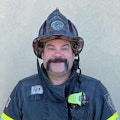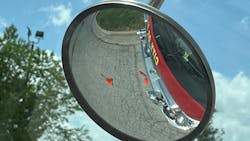Apparatus Innovations: Spotter Mirror & Backing Intercom–Quicker, More Effective & Safer Apparatus Operation
I believe in the premise that smaller, simpler apparatus are the key to a more efficient and effective fireground and emergency scene. That said, some apparatus that we operate have changed, including in regard to size, as our role has expanded. Size increases can complicate maneuverability in certain areas. The cab spotter mirror and the backing intercom, which can be added onto a current vehicle or as an option on a new apparatus purchase, increase members’ ability to respond and to return to service quickly, effectively and safely.
Officer’s side spotter mirror
The larger, taller fire apparatus cabs of today, whether conventional or cab forward, with flat or extended front bumpers, can create visual challenges for the engineer. (Note: I recommend departments choose a flat bumper or a maximum of a 19-inch front bumper extension. Front bumpers that exceed 19 inches tend to create challenges for approach angles, turning in tight spaces and backing into tight spaces.) The officer’s side spotter mirror increases an engineer’s ability to see during parking, turning and backing.
Convex spotter mirrors are used in many industries to increase operator visibility. When it’s used on a fire apparatus, a convex spotter mirror allows the engineer to see people, animals and objects that are within 1–7 feet of the front bumper when the rig is parked. The distance that’s desired plays into the specification of the mirror when department personnel communicate with suppliers or apparatus manufacturers.
Furthermore, the engineer has a full view of the topside of the front bumper. This allows that member to see loose or unsecured equipment. The engineer also can view the nearby pavement to ensure that children and animals aren’t in close proximity of the apparatus.
When making left turns while moving forward in tight parking lots and on congested city streets, streets that have obstructions and rural roads, the mirror allows the engineer to spot the left turn. This is critical, given that apparatus cabs now are commonly 100 inches (8⅓ feet) wide. Neighborhood streets can be as narrow as 20 feet in an urban setting and 24 feet in suburban areas. Add in parked cars, and the street size is even more cramped.
In the case of a 19-inch front bumper, an additional 8 inches of bumper swing should be accounted for when turning or backing left or right. When backing on streets and in parking lots, the mirror allows the engineer to account for the bumper swing.
One additional point: All departments that are specifying a new fire apparatus should request a turning performance analysis report from the manufacturer.
Backing intercom
Rearview cameras are becoming a more common option on fire apparatus. Some models include one-way audio capability. This allows the engineer to hear the directing member call out commands as the apparatus is backing. Of course, the downside to this technology is the engineer or officer doesn’t have the ability to communicate back to the directing member.
Specifying a basic backing intercom system on an engine or aerial apparatus provides for two-way communication.
Place the master intercom box between the engineer and officer, ideally at an angle on the motor house closest to the engineer and within arm’s reach of the officer.
The master intercom box contains a speaker, a push-to-talk button and a volume knob. A master power switch for on/off capability is recommended on the hard-wired switch panel. This allows the system to be turned off when it isn’t in use, thus reducing unneeded noise/
distractions in the cab.
A second speaker is placed at the tailboard of the engine or aerial apparatus. When the master switch is activated, the member at the tailboard has hands-free voice communication with the engineer and officer in the cab. If needed, the officer can activate the push-to-talk button to allow him/her or the engineer to communicate with the directing member.
Use of the system isn’t limited to backing. On arrival at an incident, if a member exits the cab to forward lay from a hydrant, the system can be used to notify the member that an audible was called and he/she must return to the cab or reposition elsewhere.
New or retrofit
The spotter mirror and backing intercom can be specified on a new apparatus purchase or added onto an existing apparatus to increase member safety while maintaining an aggressive, all-hazards response when responding to and returning from an alarm.
About the Author

Rick Mosher
Rick Mosher has been a firefighter for 28 years. He currently serves as a fire captain for the Olathe, KS, Fire Department (OFD) and is assigned to Engine Co. 4. Mosher has been involved in fire apparatus design for 26 years and leads the OFD fire apparatus design team. He is a past presenter of Critical Engine Company Concepts at Wichita HOT. Mosher is an instructor with the Fools of Oz and Make The Move Training LLC, focusing on engine company operations. He holds an associate degree in fire service administration and a bachelor’s degree in management and human relations.

